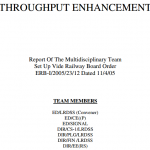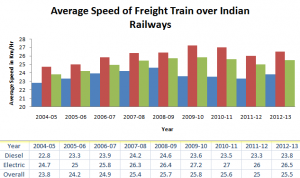How to manage the damaging effect of speed differential to improve train mobility?
IR to improve its mobility of freight train by revisiting Newton First law and make sure non-stop running of freight train for a target of minimum 4 hours.
Every railwayman has a strong want to see Indian Railways succeed in its mission to be a national transporter of passenger and freight at most economical cost. Transport on rail is six times more energy-efficient as compared to the road. This basic thumb rule shall reflect in the fare and freight tariff, then only public perception towards it will change.
It was Railways, which arrived first in the service of civilization to provide transport and public road vehicle followed after about 80 years. By this time, the infrastructure to support rail transport got built and had the maximum share of traffic. But with many of the advantages associated with road transport such as door to door connectivity, movement of smalls, timely delivery, and hassle-free movement, least gestation period, the preference shifted towards the road. This result is a continuous decline in its share and Railways blamed for its dwindling share of transport.
As in Feb.2013, the road transport sector has around 80% share of the country’s freight, while the Railways’ share has been steadily decreasing — from 32% in 2002 to 20% at present. Industry estimates suggest that the share of cement, which is one of the major bulk cargo items, has dropped by 8%-9%. With crude fallen to 5 years low and BJP Government working day and night to built highways and expressways, the time is not far when the rail share will drop down to about 15% limited to coal and iron ore.
You ask anybody, the reason given for this decline is that IR not building systems to garner more share due to the continued decline in capital funding. This has gone so deep-rooted in our thought process, and successive MR has fallen for it. It has completely blocked the inward-looking approach to sorting out issues which are possible with budgeted investment. Share projection should have sent a shocking wave to Rail Bhawan but unmindful and complacent Railways, continues to keep a vision of a year or two, that is the tenure of the Board Member. Instead of looking inward, it has given its shopping list to MR to keep him busy in arranging investments.
I have come across a very interesting study by a committee of Executive Directors in the year 2005 on ways to improve “Throughput”. This  report has not made any change in the thought process of the decision-makers and gone down the drain. I thought it relevant to present some of the findings of the committee and dovetailing it with my perception of time corridor at the national level. There are many if and buts which will be raised, but unless done, at least for a limited section having a sectional constraint, benefits cannot be comprehended.
report has not made any change in the thought process of the decision-makers and gone down the drain. I thought it relevant to present some of the findings of the committee and dovetailing it with my perception of time corridor at the national level. There are many if and buts which will be raised, but unless done, at least for a limited section having a sectional constraint, benefits cannot be comprehended.
Passenger Train mobility
Passenger train mobility is governed by timetabling. But it is unfortunate that the trains are not standardized. Why all the trains running on a route are identical to each other. All coaching trains shall run in a passenger time corridor. The following are applicable.
- The average speed of Fast, slow and EMU/MEMU trains over Indian Railways is 50, 36 and 40 Kmph respectively.
- The passenger train runs with a speed differential due to varying commercial speed and timetabling, requiring precedence of one passenger train over another. This is so even when the maximum permissible speed potential of track and rolling stock is the same. This is a case of self-inflicted damage to mobility. There is a need to rework on the timetable to run all trains in a 4-5 passenger time corridor of 1-2 hours. Each train shall be examined for pushing to the shadow of the nearest train. This will make all the to run as a cluster and convoy in a shadow path of the train ahead. In case there is a laggard train in between the passenger corridor, the same shall be powered by HHP locomotive to minimize the time for acceleration. The time difference between two trains more than a shadow time is a loss of sectional capacity.
- While running in a shadow path, there will be occasions when loco pilots observe Double yellow/yellow signal, the same shall be observed by running at lower speed (simple rolling) instead of braking at the signal and then accelerating.
- The average speed of the passenger corridor shall be 60+Kmph. One of the passenger corridors shall be suitably earmarked for Rajdhani type trains with an average speed of 80+. Identification of passenger corridors on the National network does not require any computerized simulation and can be done by simple graphical lines.
- Precedence of one passenger train over another is highly painful for the passengers and shall be minimized at least between the trains of the same passenger corridor.
- Introduction of a new train in a shadow path takes away the sectional capacity only to the extent of headway. And if not, it will push all freight trains in the section to loop line for taking precedence. Time Tabling authority never works to find out the damaging effect of a coaching train running out of a shadow.
- The slow-moving passenger trains stopping at all stations shall be called feeder trains and time table is prepared so that it acts as a feeder train to the fast-moving trains. MEMU/DEMU are best suited for such purpose which provides higher acceleration. These trains shall neither get nor give precedence to any freight trains. The average train of these trains shall be 40+.
Freight Train Mobility
Freight train mobility can well be gauged by the Average speed of a freight train. It is almost constant for a quarter of a century. The introduction of high-speed freight stock, high horsepower locomotive, high-speed turnouts etc. has not been able to make any impact on it. The trend of the average speed of freight train along with GTKM/Kg. of tractive effort is tabulated below:
 With passenger trains running in time corridor of 80, 60 and 40 Kmph, the average speed of a freight train can well be targeted for 40+ Kmph. A delight for every railwayman.
With passenger trains running in time corridor of 80, 60 and 40 Kmph, the average speed of a freight train can well be targeted for 40+ Kmph. A delight for every railwayman.
- It should be possible to accommodate all passenger trains in 4 Nos. of the time corridor of 2 hours each conveniently placed during the day. This will leave 4 corridors of 3-5 hours each for streamlining motion of freight trains covering a distance of 150-300 Km depending upon the maximum permissible speed and width of freight corridor. This will minimize the events of acceleration. Newton’s Second law states that the force required to accelerate is in direct proportion to the acceleration, and thus, additional energy consumed for each such event. There are no data of the events of stopping and accelerating 5500 T train if you do, it will tell the scope it has in saving energy and running time.
- Newton’s Third law states that every action is having an equal and opposite reaction. Every event of stopping a train and its acceleration is an action and will produce an equal reaction on the rolling stock and track resulting wear, tear and maintenance demand.
Running of trains at 160 Kmph and above on existing systems
Indian Railways have committed to GOI for its plan to upgrade the speed of 160 Kmph and above. All the trains cannot be upgraded to 160 Kmph in one go, and it will take a minimum of 15-20 years. With the above system in place, it should be possible to run all high-speed trains in a one-time corridor to derive the best output.
I am confident if IR draws national corridor and shift all fast-moving passenger trains in these corridors, it will be a sure-shot way to transform it with an accrued benefit of
-
Increase average speed to 40 Kmph as compared to 25 kmph existing today
-
Minimum 10% savings in energy and maintenance cost
-
15% increase in asset use
-
20% reduction in Loco Pilot and Guard hours
You may also like:
- ‘Rescue’ Indian Railway passenger business through statistical indices ‘RSKU’
- Average speed of freight train over Indian Railways
- Where has 150 millions Indian Railway passenger gone?
- Why no steps to digitize issue of free travel pass…
- Mechanized measurement and inspection – a help to cut down…
- Why IR passenger traffic heading south?